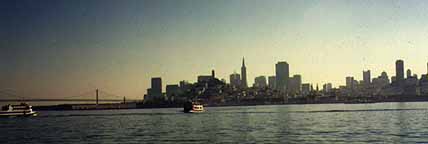
Across the Bay Bridge
American Sabbatical 043: 10/31/96
North Beach & The Rock
10/31.. North Beach
The sun actually decided to shine on the last day of October. Happy Halloween. And Berkeley is
the perfect town to celebrate all hallows in. Everyone looks like
a storybook character. We put our backsides to the sterility of
Pinole, with its blowdryed jr. execs in the Starbucks drivethru,
jammed with the endless rush-hour over to Berkeley, and went upslope
to the University. North, west, and south of the big campus there
are street scenes: outdoor cafes, huddles of homeless, drum circles
of teens living rough, and folks from every color of the rainbow.
Beret-topped beats on bikes, with goatees.. honest. Professors
in profundo tweedo, braless babes, twenty-year-old skateboarders,
purple turbans, golden saris, earnest bumperstickers, esoteric
bookstores, decorative self-mutilation and other sophisticated
college things. We rubbernecked until our heads spun, then twanged
up to our meet.
This was another venture in personal history for Peggy. Her brother’s
lifelong best friend. They traded tales until the air was thick
with mist. It’s fascinating how others’ memories of your childhood
open doors to recollection, or knock your own recall into a cocked
hat. The idea there is ONE history won’t stand up to a conversation
with your big brother’s friends.

Across the Bay Bridge
When Danny had to meet with a patient, we aimed the Owl west again,
across the bay into dreamland, San Francisco. Jim Torbert, one
of our cyber companions on the E-train, had connected us with
John and Kina, his old Peace Corps friends from the 60s, and they'd
invited us to stay in their house in North Beach. Right in the
heart of the beast.
I'd followed this idea with considerable trepidation. I'd felt
my tendons tighten as we approached megalopolis from the north.
The freeway jangle and the zoo-scene at UC Berkeley hadn’t reassured
me a bit. Coming into a big city spooks the countryman in me,
bad. Parking Red Owl on the street, on Halloween? OOhoo.
But San Francisco steals your heart instantaneously. One minute
you are jostling with machinery across miles of arched engineering,
next minute you are joyriding around in makebelieve. It’s improbable
that people drive and park on 45 degree slopes. It’s impossible
that so many charming townhouses can be stacked so high in one
place. Blossoming bay windows, dazzling bright colors, and the
patterned multiplicity of little houses climbing atop each other.
Up close to heaven this IS the most beautiful city in America.
Of course the sun had been shining all day.
Our hosts live at the end of a blind alley, one block uphill from
City Lights Bookstore, Ferlinghetti’s roost, two blocks from Chinatown,
three blocks from everything. Climb up to the third story livingspace
and you have a view to live for. Coit Tower atop Telegraph Hill
to your right, the Golden Gate behind Fishermans Wharf to your
left. Mount Tam straight ahead. Go back out the front door and
the TransAmerica Tower is down the alley, the rest of downtown
at your feet. All it lacks is parking.
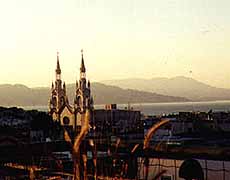
North Beach View
Ah, parking. The shade-building mechanic who works on Vallejo advised us to strip the Owl bare, feathers and all. "They’ll break in for anything they think will sell on the street." So we back up the alley and unload into John’s basement. Feels weird to turn a faithful traveling companion back into the barehulk of a vehicle, and cut her wheels hard to the curb on Vallejo. We are going to have to play wipe-the-chalk-mark with the traffic police or pay the city for parking. And we make a deal with the streetman to keep an eye on it. So there she sleeps while we do the town.
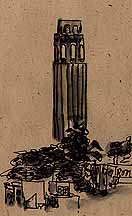
Coit Tower
We hit the pavement around mid-aft and huffed up to the top of
Telegraph Hill for a wideangle rotation of Baghdad by the bay.
Every corner you turn offers scenes of urban hideaways, private
niches, neighborhood pleasantries. You can easily imagine yourself
slipping into this burg like a hot bath. San Franciscans are marvelously
houseproud, and every private domicile is brightly painted, potted,
and pruned. It's worth climbing ladders to reach such heights.
Dark evergreens follow you up to Coit Tower and arch up beyond
you.
Then we clambered down to the waterfront and Via Tourissima. The old fishdocks have long since given way to tourist traps, from lowend honks to elegant tonks. Well, if casually, dressed visitors pointing camcorders, milled among the vendors purveying souvenirs. Isn’t it peculiar that we need to bring back trophies or our travels are unrealized? What’ll it be, mother? One-a-them Alcatraz shirts, or a sea lion mug? Bemused by the shopaholia, we strolled down Pier 39 with its two-story alleyway of redwood storefronts. Rounding the far end we were met by the bellowing music of sea lions. A dozen moored swimfloats fill a corner of the enclosed boat basin, and 60 -70 barking beasts were hauled out sunning, stretching, or squabbling. Young Turks taunting old bulls, smallfry trying to make the leap onto the floats.. a whole circus. Lined up along the pierhead was a twolegged circus gawping and clicking instamatically. Peggy, as usual, was entranced, and I had to finally lead her away by the arm, glassyeyed, mumbling “urf?....urf?”
I pointed the passive sea beast landward, through street mimes,
trumpet soloists, bungey jumps, kitsch hawkers, and kodak stands.
The best novelty we saw was a play-with-yourself tennis rig: a
sandbag connected to a tennis ball on a long elastic band, the
peddler thwocking it past tourist heads.
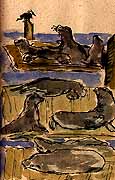
URF URF
Upstreet from the embarcadero we were back in residential Frisco, all terracotta and faded pastels. A few blocks more plunged us into the dizzy jangle of North Beach. Italian markets hardby Chinese delis, bike messengers dodging accordion busses, cafe tables spilling into the mill of foot-traffic. A gaudy gabble of signs, Chinese and English and Chinglish, climbing the walls along Columbus and the other arteries, make them look like nineteenth century photos, until you notice the microbusses. Heads full of hydrocarbons and hubbub we turned up Vallejo to dine with new friends.
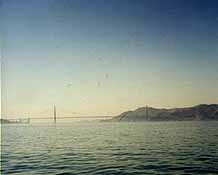
Golden Gate
John and Kina are graphic designers riding the leading edge of
the cyberwave. They created and produced a mag called GRAPHICS:
ON-LINE for some years, and the ground floor of their duplex up
the alley is an image-stuffed Macinshop webnode. The sense of
being near an epicenter vibrates strongly here.
We proposed going out for Chinese, and our hosts took us to a hot spot around the corner from City Lights. On the way we stuck our heads into The Stinking Rose, just for a blast of GARLICK. On the sidewalk in front of the Chinese holeinthewall we were marshaled into cuing clots of hungry diners, then herded into the most basic of possible bistros. Every possible inch was in use and we were shoehorned into a corner elbow-to-elbow. Our unsmiling waitress didn’t waste a breath. How many dishes? Three? OK. One this, one that.. the squid? How many tea? And the food came fast and furious. It was fantastic. You can shove me around like this anytime. And cheap! Pleasantly plumped we ambled about briefly, hearing local tales, then tottered up the incline, and to bed.
(Memo #38)
Nov. 1 - ALCATRAZ
Who? most violent prisoners
What? maximum security prison, now a tourist attraction
Where? middle of San Francisco Bay
When? prison 1909 -1962
How? ferry ride from San Francisco
Topics: prisons, social control, crime & punishment, rehabilitation,
recidivism
Questions: What was it like to be a prisoner at Alcatraz? How
can we control or change or confine people who refuse to live
by society’s rules? What is prison supposed to accomplish? Can
you rehabilitate criminals? Is criminal behavior a result of genetic
disposition or environment and upbringing (nature or nurture)?
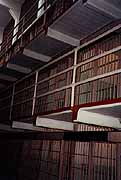
Cells
Alcatraz. The rock. The Bird Man. Inescapable island. Whirling currents. A stony outcropping in the middle of San Francisco Bay surrounded by legends. The small island is located to the north of San Francisco, a couple of miles out, in the middle of the bay as it opens out from the Golden Gate.
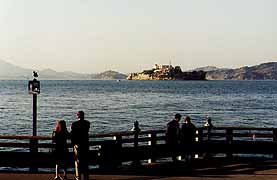
The Rock
It’s an odd concept to tour a prison. Alcatraz is a major tourist
attraction. Seeing it involves a long wait, then a ferry ride,
then a hike up a steep roadway in the company of a crowd of German
and Japanese and French and Swedish tourists all with cameras.
Then you’re in one of America’s most famous prisons. You get a
headset and set off on a self-tour. The tour takes you throughout
the major cell building with stops at a number of places to tell
you facts and stories about Alcatraz. You hear the voices of former
inmates and guards, you hear of riots and escapes.
It is a cold, bleak place of rock and metal and bars. The buildings are all beige or gray outside, gray or light green inside. Long corridors, clanging doors, high ceilings. Cement, stone, steel. Nothing softens the institutional architecture. There was no attempt to provide ease or beauty (ironically, the largest cells are in the isolation block). The exercise yard is a bare rectangle with little grass and no plantings. Signs were still posted everywhere with rules and procedures. They have not prettified Alcatraz for tourists, the paint is peeling, the floors are worn. Most of the cells are empty and you can walk in and out of them.
The main building is three stories tall, open corridors all the
way up, with three tiers (floors) of cells. There are walkways
on each level in front of the cells. At the end of the blocks
is the area patrolled by guards, barred off from the rest of the
building but with a clear view of all cell blocks.The front of
the cells are bars. The inmates had no visual privacy. The cells
are about six by ten with an iron cot attached to the wall, a
small fold-down table and seat, two shelves high on the wall,
a sink and a toilet. Cold, functional, bleak.
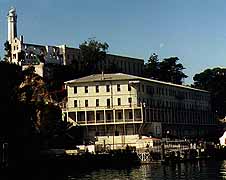
Main Building in Background
I expected a prison with its reputation to have been inhabited
since early Californian settlement. In fact, Alcatraz became a
prison in 1909 and was a military prison from 1909 -1934. It was
a federal prison only from 1934 to 1962, when it closed. Alcatraz
was a special prison, a place where men who had been violent or
difficult in other prisons were sent, a superprison for hard types.
It was never fully occupied. The island was considered secure
since the bay’s current are dangerous and the water is cold.
Alcatraz’ location was ironic. Men incarcerated for bloody crimes
had gorgeous views. While prisons in the desert are societies
unto themselves, Alcatraz had the San Francisco skyline and the
sounds of a city and bustling port to remind the men of what they
were missing. One inmate said that they could ALWAYS hear the
crowd sounds from San Francisco on New Year’s Eve. As he put it,
you could hear the life you were missing.
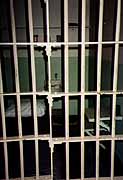
Typical Cell
There were four main corridors between the three-story blocks
of cells (A, B, C, D). They had the cells of famous prisoners
marked (Al Capone, Machine Gun Kelly, the Birdman). One inmate
drew and painted and his work is displayed in his cell. The corridors
were named for streets, Broadway and Michigan Avenue were the
two main corridors. Cell Block A (the oldest) was only used for
storage and for typing places for the men. Block D was the solitary
confinement corridor where prisoner spent 24 hour a day in their
cells (a prison within a superprison which again starts you thinking
about what a prison is supposed to accomplish and what you do
when a prisoner in a superprison won’t behave). At one end of
the cell block were small glass windows where prisoners could
see their visitors. There was no physical contact and no privacy.
You talked through a microphone. Off the main cell block there
was the barbershop, the cafeteria, the hospital, and the library.
In the cafeteria you were told to look for canisters on the ceilings
which contained gas to quell potential riots. The narrator noted
that it was dangerous to have supercriminals all together for
meals (did they ever consider feeding all the prisoners in their
cells?) You were told of one occasion when tables were overturned
and the guards ready for a riot that didn’t happen. The kitchen
area was at one end, separated by bars. They took great care to
keep track of knives. Each kitchen knife had its appointed place
on the wall, outlined in paint so its absence would be immediately
noticed.
The library was a large room with high ceiling separated from
the cell blocks by a barred wall. Ordinary prisoners were not
allowed in; books and magazines (highly censored) were delivered
to the cells by special prisoner-aides who had earned the position.
The most deadly Alcatraz riot (in which some guards and inmates
were killed) was organized with the help of a library aide who
carried messages and plans around as he distributed reading matter.
The riot took place in May 1946. Prisoners had noted the one time
in the day when only two guards were in the cell blocks. They
figured out how to overpower the guards in the cell block. One
prisoner had manufactured a bar spreader which was used to get
to the guard on the catwalk. As other guards came on duty, they
were taken hostage. The key to the exercise yard (the planned
escape route) couldn’t be found. The plotters were trapped in
the main cellblock by the attacking marines. 9 prison officers
were shot by the prisoners. We saw the holes in the ceiling in
one area where explosives were dropped on the fortified plotters.
All but one were killed.
The tape described the only successful escape from Alcatraz. Three
inmates supposedly used spoons to widen the openings from their
cells to the ventilation shaft. They left fake heads and stuffed
"bodies" under their covers in their cells (which we saw - amazing!).
No trace of them was ever found. A movie on the incident assumes
they escaped rather than drowned.
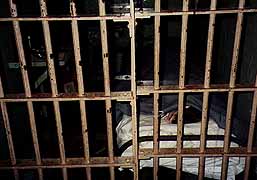
Dummy
The philosophy behind prisons has changed over the years. If the aim of prison is punishment and retribution, then there is no need for frills or comforts. Prisoners are paying dues to society. If the aim is rehabilitation and change, how is this to be accomplished? Education? Can criminals be changed, and how? Is criminal behavior genetically based, or caused by abuse or other environmental forces? Do prisoners lose their civil rights in prison? Alcatraz raises many questions. A sobering tour.
11/1.. Alcatraz.
Our San Francisco morning dawned bright and clear. A rare gift. Last evening the purple
mountains had faded, with a dreamscape of piggyback townhouses
glittered in the foreground. This morning the towers of Peter,
Paul and Coit glowed golden against the bay, and the bright jumble
of house colors smiled up at us. Paris may be called the City
of Light, but San Francisco shines on her hills like a forerunner
of paradise. When it doesn’t fog.
No fog today, and we skipped down to the waterfront to catch the
early boat to Alcatraz. Onroute we skirted a park full of elderly
Chinese, silently stretching in unison to a stretchmaster. A figure
study with a cast of 70. I felt my back straighten, and breaths
go deeper. Imagine living in a place where you can go stand on
one leg in the AM with all your neighbors.
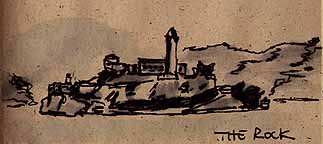
Alcatraz? you might ask. Well, Peggy has been disappointed in
the student response to her messages, and here was a hook which
might bait a few. Those who say school is like prison, maybe.
Besides, the thought of a prison as a National Park is irresistible,
and a boatride on the bay not to sniff at either. But we weren’t
early enough for the first trip, already booked solid by eager
incarcerees. So we bought tix for #2 and went to commune with
the sea lions again. You can actually see Peggy’s neck grow and
her feet broaden as she urfs along with these clowns.
When our time came, we found ourselves in a hundred-yard line
of tourists shuffling along in lockstep to be jammed nikon-to-nikon
onboard the BAY PRINCESS. SRO for the rock. No loudspeaker rap,
no fingers pointing toward the oil spill just west of the slip,
no amenities. You’re on your way to prison, son, this is a hardtime
tour.
From across the bay on Telegraph Hill, Alcatraz is a romantic
cluster of buildings capped with a skinny lighthouse on a steep
bright-beige rock. Up close it is a foreboding ruin of grim cement
structures rising like a rotten tooth from the placid waters (at
least placid today). Our nofrills ferry squeezed us out like toothpaste
onto the sloping rampway, under the foot of the prison walls,
and we shuffled uphill into History.
We’d paid for the self-guided tape tour, and it’s worth the nick. Everyone under phones has that glazed audiophonic look, and we inchwormed along from site to site with our heads full of hardcase clamor, all vaguely alienated, each in our isolated world.
It’s surprising how small this prison actually is. Although able
to house 300 some prisoners, it never caged more than 200, with
a guard for every three cons. And the three-tiered cellblocks
are the exact prototype of all those B movies you saw, only without
the shiny metal. Everything is worn, chipped, shabby, and encrusted
with institutional paint. And the din and stench must have been
astonishing. With braided lines of muttering tourists the noise
was bad enough. The experience was wonderfully oppressive, especially
backing into a solitary confinement cell or peeping though the
tiny begrimed windows at the sparkling city across the water.
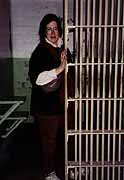
Prisoner
We were glad to be short-timers. Two hours on Alcatraz is enough
to convince you that institutional retribution is not the highwater
mark of civilization. What if all our prisons were to become tourist
attractions? Mementos of a barbaric age long past? Dream on.
We reentered contemp reality at the barking dock and hoofed overhill
for Vallejo and the Moscone Center beyond. We were going to risk
another museum despite our lingering case of museumitis. The new
Museum of Modern Art came highly recommended, along with the architectural
delights of the Yerba Buena gardens at the center, so we traipsed
downgrade for the financial district and the core of the fruit.
Mr. Natural, Flakey Foont, and that crowd must have learned to
walk in this town. You find your backs arched at funny angles
with your feet flapping ahead. It’s also a hoot to be looking
down into staid business country from makeadeal sidestreets with
girlyshows sexsexsexing all day. Going upscale downhill, we leveled
out beneath the bankers’ towers, where the girls had all their
clothes on, and the men were in pinstripe. Although all citycenters
have that concrete canyon ambiance, this town doesn’t feel as
buttoned-down or knotted tight. And the air is scrubbed with salt.
I can’t sing about the skyscrapers in a town with glorious hills.
The TransAmerica has a nifty sweeping lift, and the blueglass
music atop the Moscone Center buildings is fun, but the skydancing
townhouses steal the show.
Inside the museum I was overcome with another episode of hohum.
Computer graphics, slickprint adverts, highway engineering, the
whole of contemporary reality has pushed so far beyond the classics
of modern art as to make them irrelevant. Sorry, Pablo, give me
a hawk on the wing. This philistinism will pass, no doubt, but
I best be kept away from the august shrines of ART for a while,
or I’ll be tossing paper planes off the upper balconies.. and
OMYGOD I almost leaned against an ARTWALL. Thought it was just
designer deco in dull crayons. Take me away, officer. We cooled
ourselves in the gardens, sampled the municipal waters, and found
it good.
With luck we figured out the bus route to North Beach and sardined
in with the schoolkids and Friday rushers headed home. Witnessed
an urban drama when a shabby drunken old black man threw his arm
around a young wide-eyed white woman dressed for the office. A
muscular black with his ears full of jewelry called him off, saying,
“Hey, don’t you be messing with my wife,” winking at her. The
protector proceeded to take responsibility for jollying the drunk
for the rest of our time on the bus, and we got to inhale the
poetry of maudlin stupefaction and street-talk up Columbus.
A couple of footweary wanderers were glad to accept John and Kina's
invite for pasta at home, and we enjoyed an evening of lies and
laughter with friends of theirs, an Industrial Designer and a
Waldorf School teacher, along with Caitin, the resident teenager.
Perched on their hill, it felt very much like being at a cultural
crossroads. A fellow could get to liking a city when it’s all
at your feet.